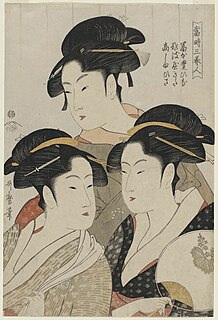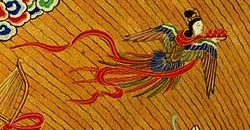
The peony or paeony is a flowering plant in the genus Paeonia, the only genus in the family Paeoniaceae. Peonies are native to Asia, Europe and Western North America. Scientists differ on the number of species that can be distinguished, ranging from 25 to 40, although the current consensus is 33 known species. The relationships between the species need to be further clarified.

Acala or Achala, also known as Acalanātha or Āryācalanātha, is a wrathful deity and dharmapala prominent in Vajrayana Buddhism and East Asian Buddhism.

The Karura (迦楼羅) is a divine creature with human torso and birdlike head in Japanese mythology.

Tosa Mitsuoki was a Japanese painter.

The Tosa school of Japanese painting was founded in the early Muromachi period, and was devoted to yamato-e, paintings specializing in subject matter and techniques derived from ancient Japanese art, as opposed to schools influenced by Chinese art, notably the Kanō school (狩野派). Tosa school paintings are characterised by "areas of flat opaque colour enclosed by simple outlines, where drawing is precise and conventional", with many narrative subjects from Japanese literature and history. However, by the 17th century both Tosa and Kanō artists broadened their range, and the distinction between these and other schools became less clear.

Bijin-ga is a generic term for pictures of beautiful women in Japanese art, especially in woodblock printing of the ukiyo-e genre.

Mianguan, also called benkan in Japan, myeonlyugwan in Korea, and Miện quan in Vietnam, is a type of crown that was traditionally worn by the Emperors of China, Japan, Korea, and kings in the cultural sphere of East Asia.

Kenzo Okada was a Japanese-born American painter and the first Japanese-American artist to work in the Abstract Expressionist style and receive international acclaim. At the 29th Venice Biennale in 1958, Okada’s work was exhibited in the Japan Pavilion alongside that of five other Japanese artists, and Okada won Astorre Meyer Prize and UNESCO Prize. He has had retrospective exhibitions at the Albright-Knox Art Gallery in 1965, the National Museum of Modern Art, Kyoto in 1966, the Seibu Museum of Art, Tokyo in 1982, the Museum of Modern Art, Toyama in 1989, the University of Iowa Museum of Art in 2000, and the Yokohama Museum of Art in 2003. Okada’s works are in the collection of the Albright-Knox Art Gallery, the Brooklyn Museum, the Metropolitan Museum of Art, the Museum of Fine Arts, Boston, the Museum of Modern Art, New York, the National Gallery of Art, Washington, D.C., the National Museum of Modern Art, Tokyo, the Peggy Guggenheim Collection, the Philadelphia Museum of Art, the San Francisco Museum of Modern Art, the Solomon R. Guggenheim Museum, the Whitney Museum of American Art, among others. According to Michelle Stuart, "when Okada came to the United States he was already a mature painter, well considered in his native Japan. To American abstraction Okada brought civilized restraint, an elegance of device and an unusual gift for poetic transmutation of natural forms."

A kapala is a skull cup used as a ritual implement (bowl) in both Hindu Tantra and Buddhist Tantra (Vajrayana). Especially in Tibet, they are often carved or elaborately mounted with precious metals and jewels.

Main hall is the building within a Japanese Buddhist temple compound (garan) which enshrines the main object of veneration. Because the various denominations deliberately use different terms, this single English term translates several Japanese words, among them butsuden, butsu-dō, kondō, konpon-chūdō, and hondō. Hondō is its exact Japanese equivalent, while the others are more specialized words used by particular sects or for edifices having a particular structure.

The Tamamushi Shrine is a miniature shrine owned by the Hōryū-ji temple complex of Nara, Japan. Its date of construction is unknown, but estimated to be around the middle of the seventh century. Decorated with rare examples of Asuka-period paintings, it provides important clues to the architecture of the time and has been designated a National Treasure.

Sukashibori is the Japanese term for openwork or pierced work, using various techniques in metalworking and other media, in which the foreground design is left intact, while background areas are cut away and removed. The resulting piece becomes see-through (sukashi) and hence the name.

Kalaviṅka is a fantastical immortal creature in Buddhism, with a human head and a bird's torso, with long flowing tail.
Gigaku (伎楽), also known as kure-gaku (呉楽) refers to an extinct genre of masked drama-dance performance, imported into Japan during the Asuka period.

Migishi Setsuko was a Japanese yōga (Western-style) painter. Known for employing vivid colors and bold strokes for still-life and landscape, Migishi contributed greatly to the establishment and elevation of the status of female artists in the Japanese art scene.
Mitsuko Tabe is a Fukuoka-based multimedia artist and was a key member in the avant-garde art group Kyūshū-ha, active between 1957 and 1968. In her Kyūshu-ha period, Tabe investigated the issues related to environmentalism and the aspects of female identity, including sexuality, procreation, and social advancement. She have worked in a variety of mediums, ranging from painting to installation to performance. After the group's dissolution, Tabe continued to work independently and advocate for the visibility of female artists in Kyūshū.

Chrysanthemum stone, sometimes called "flower stone," is a stone "flower" produced millions of years ago due to geological movement and natural formation in the rock. The stone's pattern resembles the chrysanthemum flower. The flower is milky white and grain is clear.

Ji (筓) and chai (钗) are generic term for hairpin in China. 'Ji' is also the term used for hairpins of the Qin dynasty. The earliest form of Chinese hair stick was found in the Neolithic Hemudu culture relics; the hair stick was called ji (笄), and were made from bones, horns, stones, and jade.
Hideko Fukushima, born Aiko Fukushima, was a Japanese avant-garde painter born in the Nogizaka neighborhood of Tokyo. She was known as both a founding member of the Tokyo-based postwar avant-garde artist collective Jikken Kōbō and as a talented painter infamously recruited into Art Informel circles by the critic Michel Tapié during his 1957 trip to Japan. As a member of Jikken Kōbō she not only participated in art exhibitions, but also designed visuals for slide shows and costumes and set pieces for dances, theatrical performances, and recitals. She contributed to the postwar push that challenged both the boundaries between media and the nature of artistic collaboration, culminating in the intermedia experiments of Expo '70.
















